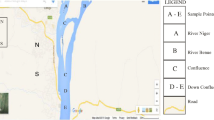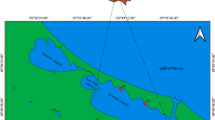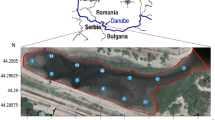Abstract
The directive 2008/105/EC suggests the use of sediment or biota matrix for long-term monitoring of specific priority pollutants that tend to accumulate. But, the intermittent nature of flow in the majority of the Mediterranean rivers results in large variability of biological communities and especially fish, making advantageous the examination of pollution trend in sediment matrix and not in living organisms (biota). In this study, sediment environmental quality standards (EQSs) and sediment quality indicators (SQIs) were used to assess pollution by heavy metals (cadmium, nickel, lead, mercury, arsenic, chromium, copper, and zinc) and polycyclic aromatic hydrocarbons (PAHs) in Evrotas River, South Greece, monitored seasonally for 2 years (2009–2010) in five sampling sites. The results showed that, based on SQIs (geoaccumulation index (Igeo), enrichment factor (EF), and modified degree of contamination (mCd)), sediments of the Evrotas River can be classified as “low polluted,” with some exceptions of “extreme pollution.” EQS assessment revealed heavy metal pollution ranging from “low” to “medium high.” Furthermore, based on the Hakanson’s ecological risk index (RI) method, heavy metal potential risk was classified from “low” to “extreme.” Cadmium showed the highest RI values, while mercury reached “moderate” pollution level. The average ΣPAH concentration (24.4 ng g−1) was lower than both the reported EQSs and the values found in literature for unpolluted or moderately polluted river sediments. Increased heavy metal and PAH concentrations were found in sites where mixing of freshwater with reclaimed water occurred. EQSs are suggested to be supplemented with the RI or EF index that consider the natural background to assist a first ecorisk assessment and should be foreseen by 2008/105/EC directive. Sediments can be considered as a valuable matrix in assessing the spatial and temporal trends of several contaminants and should be included in the monitoring program of temporary river management plans. Special attention should be given when defining reference sites and the sampling period. Decreasing flow period at the beginning of the spring prevailed in order to diminish any disturbance by flash flood events.





Similar content being viewed by others
References
Bednarova, Z., Kuta, J., Kohut, L., Machat, J., Klanova, J., Holoubek, I., Jarkovsky, J., Dusek, L., & Hilscherova, K. (2013). Spatial patterns and temporal changes of heavy metal distributions in river sediments in a region with multiple pollution sources. Journal of Soils and Sediments, 13(7), 1257–1269. doi:10.1007/s11368-013-0706-2.
Botsou, F., & Hatzianestis, I. (2012). Polycyclic aromatic hydrocarbons (PAHs) in marine sediments of the Hellenic coastal zone, eastern Mediterranean: levels, sources and toxicological significance. Journal of Soils and Sediments, 12, 265–277.
Burton, G. A., Jr. (2013). Assessing sediment toxicity: past, present, and future. Environmental Toxicology and Chemistry, 32, 1438–1440.
CCME (2003) Canadian environmental quality guidelines canadian council of ministers of the environment, Winnipeg.
Chapman, P. M., & Mann, G. S. (1999). Sediment quality values (SQVs) and ecological risk assessment (ERA). Marine Pollution Bulletin, 38, 339–344.
Chapman, P. M., Barrick, R. C., Neff, J. M., & Swartz, R. C. (1987). Four independent approaches to developing sediment quality criteria yield similar values for model contaminants. Environmental Toxicology and Chemistry, 6, 723–725.
Chapman, P. M., Allard, P. J., & Vigers, G. A. (1999a). Development of sediment quality values for Hong Kong special administrative region: a possible model for other jurisdictions. Marine Pollution Bulletin, 38, 161–169.
Chapman, P. M., Wang, F., Adams, W. J., & Green, A. (1999b). Appropriate applications of sediment quality values for metals and metalloids. Environmental Science and Technology, 33, 3937–3941.
Cui, X., Mayer, P., & Gan, J. (2013). Methods to assess bioavailability of hydrophobic organic contaminants: principles, operations, and limitations. Environmental Pollution, 172, 223–234. doi:10.1016/j.envpol.2012.09.013.
Cui, J., Zang, S., Zhai, D., & Wu, B. (2014). Potential ecological risk of heavy metals and metalloid in the sediments of Wuyuer River basin, Heilongjiang Province, China. Ecotoxicology, 23, 589–600.
Daskalou, V., Vreča, P., Muri, G., & Stalikas, C. (2009). Recent environmental changes in the shallow lake Pamvotis (NW Greece): evidence from sedimentary organic matter, hydrocarbons, and stable isotopes. Archives of Environmental Contamination and Toxicology, 57, 21–31.
Datry, T., Larned, S. T., & Tockner, K. (2014). Intermittent rivers: a challenge for freshwater ecology. BioScience, 64, 229–235.
Di Toro, D., Mahony, J. D., & Hansen, D. J. (1992). Acid volatile sulfide predicts the acute toxicity of cadmium and nickel in sediments. Environmental Science & Technology, 26, 96–101.
European Commission. (2008). Directive 2008/105/EC of the European Parliament and of the Council on environmental quality standards in the field of water policy, amending and subsequently repealing Council Directives 82/176/EEC, 83/513/EEC, 84/156/EEC, 84/ 491/EEC, 86/280/EEC and amending Directive 2000/60/EC (p. L 348 84). Luxembourg: Office for Official Publications of the European Communities.
EC (2010) Guidance document No. 25 on chemical monitoring of sediment and Biota under the WaterFramework Directive. Common implementation strategy for the water framework directive technical report-2010-041 doi:10.2779/43586.
EC (2011) Guidance document No. 27, Technical guidance for deriving environmental quality standards doi:10.2779/43816.
Fu, J., et al. (2011). Polycyclic aromatic hydrocarbons in surface sediments of the Jialu River. Ecotoxicology, 20, 940–950.
Gamvroudis, C., Nikolaidis, N. P., Tzoraki, O., Papadoulakis, V., & Karalemas, N. (2015). Water and sediment transport modeling of a large temporary river basin in Greece. Science of the Total Environment, 508, 354–365.
Gonul, L. T., & Kucuksezgin, F. (2012). Aliphatic and polycyclic aromatic hydrocarbons in the surface sediments from the Eastern Aegean: assessment and source recognition of petroleum hydrocarbons. Environmental Science and Pollution Research, 19, 31–41.
Hahladakis, J., Smaragdaki, E., Vasilaki, G., Gidarakos, E. (2012) Use of sediment quality guidelines and pollution indicators for the assessment of heavy metal and PAH contamination in Greek surficial sea and lake sediments. Environmental Monitoring and Assessment:1–11
Hakanson, L. (1980). An ecological risk index aquatic pollution control, a sedimentological approach. Water Research, 14, 975–1001.
Haritash, A. K., & Kaushik, C. P. (2009). Biodegradation aspects of polycyclic aromatic hydrocarbons (PAHs): a review. Journal of Hazardous Materials, 169, 1–15.
Kaushik, C. P., Sangwan, P., & Haritash, A. K. (2012). Association of polycyclic aromatic hydrocarbons (PAHs) with different sizes of atmospheric particulate in Hisar City and its health aspects. Polycyclic Aromatic Compounds, 32, 626–642.
Lekkas, T., et al. (2004). Evaluation of the pollution of the surface waters of Greece from the priority compounds of List II, 76/464/EEC Directive, and other toxic compounds. Environment International, 30, 995–1007.
Li, F., Huang, J., Zeng, G., Yuan, X., et al. (2013). Spatial risk assessment and sources identification of heavy metals in surface sediments from the Dongting Lake, Middle China. Journal of Geochemical Exploration, 132, 75–83.
Liu, F., Liu, J., Chen, Q., Wang, B., Cao, Z. (2013a) Pollution characteristics and ecological risk of polycyclic aromatic hydrocarbons (PAHs) in surface sediments of the southern part of the Haihe River system in China. Chinese Science Bulletin:1–9
Liu, Y., et al. (2013b). Comparison of sedimentary PAHs in the rivers of ammer (Germany) and liangtan (China): differences between early-and newly-industrialized countries. Environmental Science and Technology, 47, 701–709.
Long, E. R., MacDonald, D. D., Smith, S. L., & Calder, E. D. (1995). Incidence of adverse biological effects within ranges of chemical concentrations in marine and estuarine sediments. Environmental Management, 19, 81–97.
López-Bermúdez, F., Romero-Díaz, A., Martínez-Fernandez, J., & Martínez-Fernandez, J. (1998). Vegetation and soil erosion under a semi-arid Mediterranean climate: a case study from Murcia (Spain). Geomorphology, 24, 51–58. doi:10.1016/S0169-555X(97)00100-1.
MacDonald, D. D., Ingersoll, C. G., & Berger, T. A. (2000). Development and evaluation of consensus-based sediment quality guidelines for freshwater ecosystems. Archives of Environmental Contamination and Toxicology, 39, 20–31.
Nikolaidis, N., et al. (2013) Towards a sustainable management of Mediterranean river basins - Policy recommendations on management aspects of temporary streams. Water Policy In press
Okoro, D., & Ikolo, A. O. (2007). Sources and compositional distribution of polycyclic aromatic hydrocarbons in soils of Western Niger Delta. Journal of Applied Science and Technology, 12, 35–40.
Papadopoulou, D., & Samara, C. (2002). Polycyclic aromatic hydrocarbon contamination and Lumistox® solvent extract toxicity of marine sediments in the north Aegean Sea Greece. Environmental Toxicology, 17, 556–566.
Patrolecco, L., Ademollo, N., Capri, S., Pagnotta, R., & Polesello, S. (2010). Occurrence of priority hazardous PAHs in water, suspended particulate matter, sediment and common eels (Anguilla anguilla) in the urban stretch of the River Tiber (Italy). Chemosphere, 81, 1386–1392.
Prat Nea (2013) The MIRAGE toolbox: an integrated assessment tool for temporary streams river research and applications: In Review
Prat, N., Gallart, F., Von Schiller, D., Polesello, S., García-Roger, E. M., Latron, J., Rieradevall, M., Llorens, P., Barberá, G. G., Brito, D., De Girolamo, A. M., Dieter, D., Lo Porto, A., Buffagni, A., Erba, S., Nikolaidis, N. P., Querner, E. P., Tournoud, M. G., Tzoraki, O., Skoulikidis, N., Gómez, R., Sánchez-Montoya, M. M., Tockner, K., & Froebrich, J. (2014). The mirage toolbox: an integrated assessment tool for temporary streams. River Research and Applications, 30, 1318–1334. doi:10.1002/rra.2757.
Prica, M., Dalmacija, B., Rončević, S., Krčmar, D., & Bečelić, M. (2008). A comparison of sediment quality results with acid volatile sulfide (AVS) and simultaneously extracted metals (SEM) ratio in Vojvodina (Serbia) sediments. Science of the Total Environment, 389, 235–244. doi:10.1016/j.scitotenv.2007.09.006.
Skoulikidis, N. T., Vardakas, L., Karaouzas, I., Economou, A. N., Dimitriou, E., & Zogaris, S. (2011). Assessing water stress in Mediterranean lotic systems: Insights from an artificially intermittent river in Greece. Aquatic Sciences, 73, 581–597.
Stoddard, J. L., Larsen, D. P., Hawkins, C. P., Johnson, R., & Norris, R. (2006). Setting expectations for the ecological condition of streams: the concept of reference condition. Ecological Applications, 16(4), 1267–1276.
Tzoraki, O., Nikolaidis, N. P., Amaxidis, Y., & Skoulikidis, N. T. (2007). In-stream biogeochemical processes of a temporary river. Environmental Science and Technology, 41, 1225–1231.
Tzoraki, O., Nikolaidis, N., Cooper, D., & Kassotaki, E. (2014). Nutrient mitigation in a temporary river basin. Environmental Monitoring and Assessment, 186, 2243–2257. doi:10.1007/s10661-013-3533-4.
Tzoraki, O., Nikolaidis, N. P., Keldjsen, T., Cooper, D., Gamvroudis, C., Gallart, F., Froebrich, J., & Querner, E. (2013). Flood Generation and Classification of a semi-arid Intermittent flow watershed: Evrotas river. International Journal River Basin Management, 11(1), 1–16.
Violintzis, C., Arditsoglou, A., & Voutsa, D. (2009). Elemental composition of suspended particulate matter and sediments in the coastal environment of Thermaikos Bay, Greece: delineating the impact of inland waters and wastewaters. Journal of Hazardous Materials, 166, 1250–1260.
Wang, Y., Li, X., Li, B. H., Shen, Z. Y., Feng, C. H., & Chen, Y. X. (2012). Characterization, sources, and potential risk assessment of PAHs in surface sediments from nearshore and farther shore zones of the Yangtze estuary China. Environmental Science and Pollution Research, 19, 4148–4158.
Zhang, L., & Liu, J. (2014). In situ relationships between spatial–temporal variations in potential ecological risk indexes for metals and the short-term effects on periphyton in a macrophyte-dominated lake: a comparison of structural and functional metrics. Ecotoxicology, 23, 553–566.
Zhang, Y., & Wang, J. (2010). Pollution survey and source identification of polycyclic aromatic hydrocarbons in surface soil of Jiaxing (pp 204–209). China.
Zhao, J., Zhang, F., Chen, J., & Xu, Y. (2010). Characterization of polycyclic aromatic hydrocarbons and gas/particle partitioning in a coastal city, Xiamen, Southeast China. Journal of Environmental Sciences, 22, 1014–1022.
Zoppini, A., Ademollo, N., Amalfitano, S., Casella, P., Patrolecco, L., & Polesello, S. (2014). Organic priority substances and microbial processes in river sediments subject to contrasting hydrological conditions. Science of the Total Environment, 484, 74–83.
Acknowledgments
The research reported here received funding from the European Community’s Seventh Framework Program (FP7/2007-2011) under grant agreement 211732 (MIRAGE project. We would like to thanks Vassilis Papadoulakis (Lakonia Prefecture, GR) and Leonidas Vardakas (HCMR, GR) for assisting in sediment sampling, Sarou Maria-Lilly (TUC) for heavy metal analysis, and Stefano Polesello (IRSA) for helpful discussion and draft revision.
Author information
Authors and Affiliations
Corresponding author
Rights and permissions
About this article
Cite this article
Tzoraki, O., Karaouzas, I., Patrolecco, L. et al. Polycyclic Aromatic Hydrocarbons (PAHs) and Heavy Metal Occurrence in Bed Sediments of a Temporary River. Water Air Soil Pollut 226, 421 (2015). https://doi.org/10.1007/s11270-015-2671-4
Received:
Accepted:
Published:
DOI: https://doi.org/10.1007/s11270-015-2671-4




